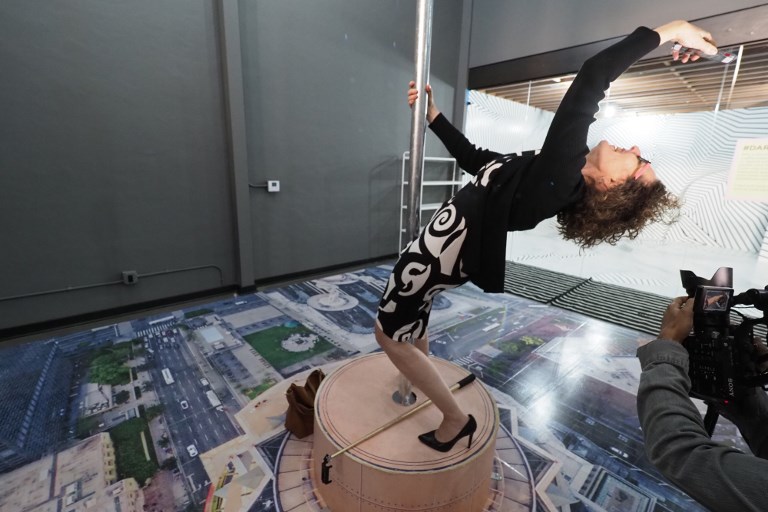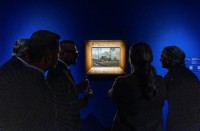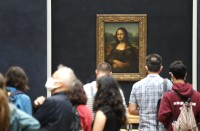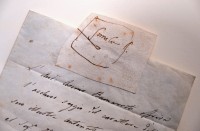
by Javier Tovar
© Agence France-Presse
GLENDALE, United States (AFP) — There’s an art to taking the perfect selfie — from the angle, to the focus, cropping out that pesky outstretched arm and above all, the smile.
In a celebration of self-portraits in the social media age Tommy Honton and Tair Mamedov are set to open the Museum of Selfies in Los Angeles this Sunday — an interactive exhibition exploring the history and cultural phenomenon of snapping a photo of yourself.
And for those who think if a moment wasn’t photographed, it might as well have not happened — the good news is that at the Museum of Selfies, selfies are compulsory.
Event planner Lori Nguyen, 45, said she doesn’t take selfies very often because “I’m not, like, super young.”
But another visitor, Nina Crowe, said she takes “one a day.”
Neither missed the chance to snap several at the Museum of Selfies, including at an exhibit mimicking the rooftop of Los Angeles’ tallest building.
In reality there’s a backdrop photograph of the “ground below” printed on a small platform, from which sprouts a tube that looks like the building’s antenna complete with a red signaling beacon.
Add a selfie stick, an “I’m afraid of heights” grimace and a click — and the result is very realistic.
The exhibition begins with mirrors, perhaps the most basic kind of selfie. But Honton and Mamedov view the concept as something more than just a simple photo.
“The selfies have a surprisingly rich history, and go back as far as people have been making art,” Honton explains.
“Rembrandt did hundreds of self-portraits, Albrecht Durer five, Van Gogh dozens. I mean they did their portraits too, what’s the difference?” he said.
“Yes, artistic technique and scale is one thing, but in reality, if cell phones and cameras had existed, everyone would have taken them.”
Another selfie museum opened in the Philippines in 2015, but there’s no sign it stayed open. Meanwhile in Glendale, a Los Angeles suburb, the exhibition is just the latest in the city’s stream of quirky museums focusing on everything from rabbits and death to neon and velvet.
‘Selfie magnet’
The show is full of fun facts about the trend: women take pictures of themselves more than men, for example.
In Sao Paulo, 65.4 percent of selfies are taken by women — in New York, 61.6 percent. In Moscow, the divide is even more extreme, at 82 percent.
There aren’t statistics for Los Angeles, but Ally Bertik admits she is a frequent selfie-snapper.
“It shows off my good side. And I get to show people like ‘hey, this is where I am, maybe you guys should check it out too, this is what I’m doing.’ It’s just a fun way to like spread you know what I’m doing, show people where I’m at,” she explained.
Wandering through the museum, guests will be able to pose with Colette Miller’s “Angel Wings” and a work by Darel Carey, who creates multi-dimensional rooms using plastic tape — a concept the museum describes as a “selfie magnet.”
There are pieces by Brazil’s Rob Vital, German-Canadian Joseph Nowak, Italy’s Michele Durazzi — and a copy of the Russian government’s recommendations for taking a selfie safely, created following several accidents and as many as 12 selfie-related deaths in the country.
Also featured is David Slater’s controversial monkey selfie — which became embroiled in a legal battle over who has the copyright to photos taken by monkeys using his camera.
In a corner, meanwhile, are three statues resembling Michelangelo’s “David” — painted blue with a pink cell phone — and a Game of Thrones-esque throne created using selfie sticks.
You just “can’t avoid” taking a selfie there, says Mamedov, a Russian actor who arrived in the US four years ago.
The Museum of Selfies will be open in Glendale initially for two months. Its founders are open to extending its LA run and taking the exhibition to other places around the US, if not the world.
© Agence France-Presse







